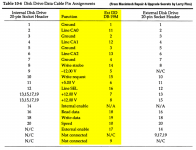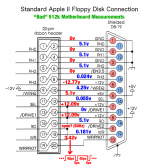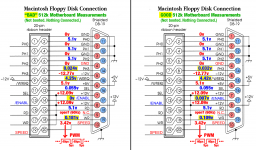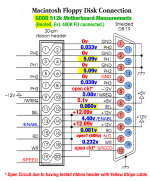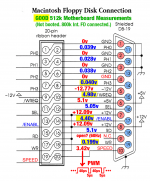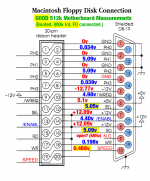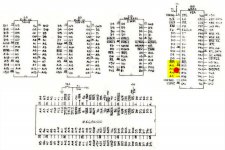JDW
Well-known member
Well, I'm in tears again over my own foolishness. I've been shooting a video that focuses on recapping of 400K floppy drives. I hadn't begun the actual recapping but was doing some preliminary tear-aparts and testing. I had my 400K floppy drive mechanism connected via ribbon cable to my 512K motherboard, but I had the drive mechanism pulled outside the back (with the back case off) and sitting on some plastic floppy disk cases. I had a single jumper wire with alligator clips at either end connected to the metal chassis of the Mac and to the metal chassis of the floppy drive. All was going fine until I switched on power and noted there was no Bong sound! I looked down in horror to see one end of my alligator clip wire had fallen off the floppy drive and onto the 512k motherboard, shorting one or two pins of the SYP6522 (about where the red dot is shown below) to Chassis ground (connected to Earth via wall socket).
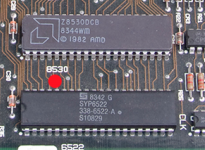
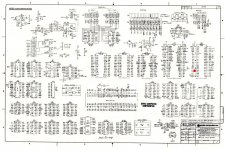
With my heart racing and sweat on my brow, I immediately switched off the machine and removed the jumper wire. When I switched on the machine, to my delight I was able to hear the startup bong! And when I put in a disk, the 400K drive would spin the disk and move the head to try to read from it. It spit out the disk, but the drive had been spitting it out prior to the Epic Blunder because I think the disk was bad. Anyway, I then booted from my FloppyEMU (which was also attached at the time on the external Floppy connector), and it booted to the Desktop just fine. Thinking that all was well, I put in the same disk into my 400K drive, but the drive motor didn't spin. Basically nothing happened, just as if I had the 400K drive disconnected and inserted a disk. I then shutdown the machine and powered on, then put the disk back in, but the drive still wouldn't spin the disk or move the head! And yet, when I power on each time, I do see the head move a few millimeters as it normally does at cold boot. Even so, disk insertion results in no motor spinning and no head movement at all. Yet my FloppyEMU works perfectly every time I try it.
I have another 400K floppy drive, known good, so with the machine powered off, I disconnected my dead 400K drive and I connected that other known-good drive via the same ribbon cable to the motherboard -- it too is an internal 400K drive mechanism. That 400K drive accepted my floppy, tried to read it but couldn't, then spit it out. So I booted from my FloppyEMU (still connected), and at the Desktop I inserted my floppy again. Sadly, this second drive has now stopped spinning the motor! I powered off and on, then inserted the floppy again, but it still won't spin and the head won't move. But like the other drive, when I power on, I see the head move just very slightly as it normally does (which happens even when no floppy is inserted).
So why would the head move a little at power-on, but then give me no motion at all when I insert a floppy? And why would both of these drives accept the floppy the first time, try to read it, then spit it out (perfectly normal when a bad disk is inserted), but then after booting to the desktop (via FloppyEMU) suddenly stop working?
If the above schematic is to be believed, it would appear I may have shorted one or more of the address lines (pins 36 and/or 37??) to Ground with that stupid jumper wire. But why would a short there ultimately kill both of my 400K floppy drive mechanisms?
I have another 512K motherboard, but I'm a bit scared to test my 400K drives with it for fear that whatever now plagues the 400K drives could harm that motherboard too.
I would certainly appreciate hearing your thoughts and suggestions, especially yours, @Bolle.
Thank you.


With my heart racing and sweat on my brow, I immediately switched off the machine and removed the jumper wire. When I switched on the machine, to my delight I was able to hear the startup bong! And when I put in a disk, the 400K drive would spin the disk and move the head to try to read from it. It spit out the disk, but the drive had been spitting it out prior to the Epic Blunder because I think the disk was bad. Anyway, I then booted from my FloppyEMU (which was also attached at the time on the external Floppy connector), and it booted to the Desktop just fine. Thinking that all was well, I put in the same disk into my 400K drive, but the drive motor didn't spin. Basically nothing happened, just as if I had the 400K drive disconnected and inserted a disk. I then shutdown the machine and powered on, then put the disk back in, but the drive still wouldn't spin the disk or move the head! And yet, when I power on each time, I do see the head move a few millimeters as it normally does at cold boot. Even so, disk insertion results in no motor spinning and no head movement at all. Yet my FloppyEMU works perfectly every time I try it.
I have another 400K floppy drive, known good, so with the machine powered off, I disconnected my dead 400K drive and I connected that other known-good drive via the same ribbon cable to the motherboard -- it too is an internal 400K drive mechanism. That 400K drive accepted my floppy, tried to read it but couldn't, then spit it out. So I booted from my FloppyEMU (still connected), and at the Desktop I inserted my floppy again. Sadly, this second drive has now stopped spinning the motor! I powered off and on, then inserted the floppy again, but it still won't spin and the head won't move. But like the other drive, when I power on, I see the head move just very slightly as it normally does (which happens even when no floppy is inserted).
So why would the head move a little at power-on, but then give me no motion at all when I insert a floppy? And why would both of these drives accept the floppy the first time, try to read it, then spit it out (perfectly normal when a bad disk is inserted), but then after booting to the desktop (via FloppyEMU) suddenly stop working?
If the above schematic is to be believed, it would appear I may have shorted one or more of the address lines (pins 36 and/or 37??) to Ground with that stupid jumper wire. But why would a short there ultimately kill both of my 400K floppy drive mechanisms?
I have another 512K motherboard, but I'm a bit scared to test my 400K drives with it for fear that whatever now plagues the 400K drives could harm that motherboard too.
I would certainly appreciate hearing your thoughts and suggestions, especially yours, @Bolle.
Thank you.

